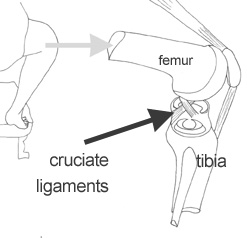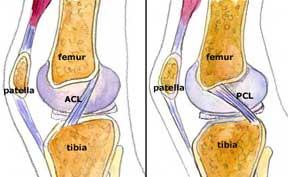-
The cruciate ligaments
- Cruciate ligament tears
- The torn anterior cruciate ligament (ACL)
- The torn posterior cruciate ligament (PCL)
- Multiligament instability of the knee
- Cruciate ligament repair
- Cruciate ligament reconstruction
- Cruciate ligament rehabilitation
- Complications of cruciate reconstruction
 Pages updated July 2023 by Dr Sheila Strover (Clinical Editor)
Pages updated July 2023 by Dr Sheila Strover (Clinical Editor)
What are the cruciate ligaments?

The cruciate ligaments are the central ligament stabilisers of the knee. They are strong bands of ligament tissue that allow the normal knee movement of bending and straightening, as well as some rotation of the knee, but prevent excessive movement or dislocation of the femur and tibia bones. That is, they maintain knee stability - in conjunction with the other stabilisers like the collateral ligaments and the menisci. The ligament you can see arising from the front of the tibia is called the anterior cruciate ligament (ACL), and the one arising behind it is the posterior cruciate ligament (PCL).
The ACL versus the PCL

In this illustration these knee bones have been cut open down the middle of the joint so that you can see the full extent and direction of each cruciate ligament.
It is easy to see that the anterior cruciate ligament (ACL) holds the tibia from sliding forwards. The posterior cruciate ligament (PCL) holds the tibia from sliding backwards. The combined action of the two strong ligaments is to prevent 'antero-posterior' ('forwards-backwards') instability.
NEXT PART: Cruciate ligament tears
